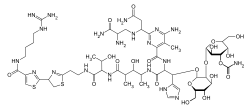Zeocin
Zeocin is a formulation of phleomycin D1, a glycopeptide antibiotic and one of the phleomycins from Streptomyces verticillus belonging to the bleomycin family of antibiotics.[1] It is a broad-spectrum antibiotic that is effective against most bacteria, filamentous fungi, yeast, plant, and animal cells. It causes cell death by intercalating into DNA and inducing double stranded breaks of the DNA.[2][3]
 | |
| Names | |
|---|---|
| IUPAC name
2-({2-[2-{[(6-Amino-2-{3-amino-1-[(2,3-diamino-3-oxopropyl)amino]-3-oxopropyl}-5-methyl-4-pyrimidinyl)carbonyl]amino}-3-[(5-{[1-({2-[4-({4-[(diaminomethylene)amino]butyl}carbamoyl)-4’,5’-dihydro-2,4’-bi-1,3-thiazol-2’-yl]ethyl}amino)-3-hydroxy-1-oxo-2-butanyl]amino}-3-hydroxy-4-methyl-5-oxo-2-pentanyl)amino]-1-(1H-imidazol-5-yl)-3-oxopropoxy]-4,5-dihydroxy-6-(hydroxymethyl)tetrahydro-2H-pyran-3-yl}oxy)-3,5-dihydroxy-6-(hydroxymethyl)tetrahydro-2H-pyran-4-yl carbamate | |
| Identifiers | |
3D model (JSmol) |
|
| ChEBI | |
| ChemSpider | |
PubChem CID |
|
| UNII | |
| |
| |
| Properties | |
| C55H86N20O21S2 | |
| Molar mass | 1427.53 g·mol−1 |
Except where otherwise noted, data are given for materials in their standard state (at 25 °C [77 °F], 100 kPa). | |
| Infobox references | |
Properties
Zeocin is blue in colour due to the presence of copper ion Cu2+. The copper-chelated form of zeocin is inactive. When zeocin enters a cell, the Cu2+ is reduced to Cu+ and then removed, and zeocin becomes activated and can then bind DNA.[1]
Usage
Zeocin and other related chemicals in the bleomycin family of compounds are primarily used in molecular biology as an antibiotic, especially for the selection of eukaryotic cell lines when used in conjunction with vectors containing a selectable marker for zeocin resistance. Zeocin is considerably cheaper than phleomycin, works better in minimal media, and is therefore often used preferentially in studies.[4]
Resistance to zeocin is conferred by the product of the Sh ble gene first isolated from Streptoalloteichus hindustanus.[5] The Sh ble gene product binds the antibiotic in a one-to-one ratio so it can no longer cause cleavage of DNA. This resistance gene is used as a selectable marker in some cloning and expression vectors where zeocin is used as the antibiotic for selection.[6][7]
References
- "Zeocin Selection Reagent - User Guide" (PDF). Invitrogen.
- Ehrenfeld GM, Shipley JB, Heimbrook DC, Sugiyama H, Long EC, van Boom JH, van der Marel GA, Oppenheimer NJ, Hecht SM (1987). "Copper-dependent cleavage of DNA by bleomycin". Biochemistry. 26 (3): 931–42. doi:10.1021/bi00377a038. PMID 2436656.
- Chankova SG, Dimova E, Dimitrova M, Bryant PE (2007). "Induction of DNA double-strand breaks by zeocin in Chlamydomonas reinhardtii and the role of increased DNA double-strand breaks rejoining in the formation of an adaptive response". Radiation and Environmental Biophysics. 46 (4): 409–16. doi:10.1007/s00411-007-0123-2. PMID 17639449.
- Benko Z, Zhao RY (2011). "Zeocin for selection of bleMX6 resistance in fission yeast" (PDF). BioTechniques. 51 (1): 57–60. doi:10.2144/000113706. PMID 21781055.
- Gatignol, A., Durand, H. & Tiraby, G. (1988). "Bleomycin resistance conferred by a drug-binding protein". FEBS Lett. 230: 171–175. doi:10.1016/0014-5793(88)80665-3. PMID 2450783.CS1 maint: multiple names: authors list (link)
- Pfeifer TA, Hegedus DD, Grigliatti TA, Theilmann DA (1997). "Baculovirus immediate-early promoter-mediated expression of the Zeocin resistance gene for use as a dominant selectable marker in dipteran and lepidopteran insect cell lines". Gene. 188 (2): 183–90. doi:10.1016/s0378-1119(96)00756-1. PMID 9133590.
- Mulsant P, Gatignol A, Dalens M, Tiraby G (1988). "Phleomycin resistance as a dominant selectable marker in CHO cells". Somatic Cell and Molecular Genetics. 14 (3): 243–52. doi:10.1007/bf01534585. PMID 2453083.